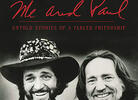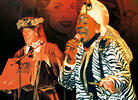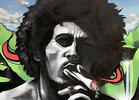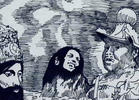
Chris Blackwell devotes about 30 pages to Bob Marley in his memoir, The Islander.
The 85-year-old founder of British-based Island Records signed Bob Marley & the Wailers in 1972. Catch a Fire, featuring the original unit of Marley, Peter Tosh and Bunny Wailer, was released the following year.
Signing the Wailers
In the "Meeting Bob Marley" chapter, Blackwell (he penned the book with Paul Morley) writes:
"I knew the Wailers, but I wasn't fluent in their recorded work... Yet here they were in my office in 1972, acting on Bunny's belief that I owed them, waiting to see what I would offer them. They showed up unannounced, plonking themselves down on my modest accomodations."
Blackwell had previously signed Jimmy Cliff. He connnected him with The Harder They Come director Perry Henzell, who hired Cliff to play Ivanhoe, the lead character in the film. But Cliff wasn't happy with the delay in the movie's release and accepted an offer from RCA Records.
This opened the door for the Wailers.
"As I took measure of them, I thought, Fuck, this is the real thing. And their timing was good. Jimmy Cliff had just walked out on me a week earlier."
Though he didn't owe the Wailers any money, Blackwell offerred them 4,000 pounds to cut a record in Kingston.
"I didn't ask them to sign anything, which was a risk, but it seemed right in this instance. They had been so fucked over and had so many scores to settle that it seemed correct to do it this way."
Creating "Catch a Fire"
A few months, later Blackwell arrived in Jamaica.
"The first song they played me was 'Slave Driver'... That first track was a masterful piece of songwriting and playing, setting the tone for what was to come over the next few years - light and dark, heavy and easy, pleasure and pain, love and resistance, an angry, deeply spiritual song sneaking up on you, the fury of it all laying in wait."
Blackwell insisted they see themselves as a Black rock band.
"The biggest change I made to their original sound was symbolized by the guitar on 'Concrete Jungle'... Having a different kind of guitar - a rock guitar with a lean, Southern-blues flavor - changed everything."
He convinced Marley to use Wayne Perkins, a white guitarist who was part of the Muscle Shoals studio group in Alabama, on the track. Blackwell brought Perkins into the studio where the Wailers were recording and he started to play.
"Bob, who had been listening intently, was thrilled. He was so excited he jumped all over Wayne, patting him on the back, stuffing a huge joint into his mouth. Wayne got pretty damned high that night - he had become a white Wailer. As for Bob, he immediately knew something important had happened: a launch in a new direction, a mysterious melding of time and place, the American South and Jamaican swagger, that somehow made sense."
"Peter Tosh didn't like me. He suggested I favored Bob because Bob was half-white... Behind my back, he referred to me as 'Whitewell' and 'Whitewirst.'"
Blackwell steered them to become a "Black guitar band."
"I took what I had learned working in rock and applied it to reggae, just as I had taken what I'd learned from producing and selling Jamaican music and applied it to running a rock label. It was coming full circle, really."
Leaving the Wailers Behind
Up until then, Islands Records mostluy consisted of artists like Traffic, King Crimson, Emerson. Lake and Palmer, Jethro Tull and Cat Stevens. But a couple of Wailers didn't see it Blackwell's way.
"Bunny, a fundamentalist Rasta, started getting anxious about the kinds of venues we wanted the Wailers to play, the rock clubs and colleges. He was unsure about the type of people who went to those clubs, their diversity. To him they were full of freaks, which freaked him out... Soon enough, the Wailers became known as Bob Marley & the Wailers. Although Tosh and Bunny were formidable talents and had great rebel presence, Bob had by far the most charisma and the most songs. He was clearly the leader - and, in a wider sense, transcending music, a leader."

Blackwell lays into Tosh:
"Peter Tosh didn't like me. He suggested I favored Bob because Bob was half-white, with an English-born father. Behind my back, he referred to me as 'Whitewell' and 'Whitewirst.' All I can say is that his suspicions were misguided, as were those who accused me of exploiting Bob to make money. I never paid a Jamaican act a penny less in royalties than an English act. I was helpless without the artists. I wasn't a singer or a writer; it made no sense to rip them off. I put my all into getting Bob's music, and Jamaica's music into the mainstream."
Shooting Marley
By 1975, Tosh and Bunny had left the Wailers and the I-Three back-up singers, including Rita Marley, took their places. In December, there was an asssination attempt on Marley, who was shot as well as Rita and manager Don Taylor. This happened during a chaotic prime minister race.
"[Bob Marley's] shooters were gangsters working on behalf of Edward Seaga's Labor Party, possibly proxies of the CIA."
"Now that he was such a public figure, everyone knew where Bob Marley's base was. He didn't want to cut himself off from the people, from the outside world. Perhaps he thought no one would make him a target. But with its poor security apparatus, his house was easily stormed by gunmen, although it is still not clear who they were and why they were shooting. One suggestion is the shooters were gangsters working on behalf of Edward Seaga's Labor Party, possibly proxies of the CIA, attacking Bob and his entourage because of his apparent ties with Prime Minister Michael Manley of the more socialist People's National Party. Others have suggested that there was a drugs link. Amazingly, and much to my relief, there were no fatalities."
A bullet grazed Marley's chest and landed in his upper arm. Three days later, he appeared at the Smile Jamaica unity concert, holding raised hands with Manley and Seaga on stage.
"He still performed in front of 80,000 people because, as he said, 'The people who are trying to make the world worse aren't taking the day off, so how can I?' He was scheduled to sing just one song in front of the huge crowd, but ended up playing for 90 minutes with the bullet freshly lodged in his arm and his wounds clearly visible."
Making "Exodus"
In 1977, Marley recorded the tracks for Exodus and Kaya, which would come out in '77 and '78 respectively. Blackwell believes this was the group's peak.
"When Exodus appeared, to my mind it was like Jimi Hendrix coming out with Electric Ladyland... Does it stand out for me as Bob's best? Probably, but it's close. Catch a Fire is fantastic, an experiment in blending differerent kinds of music that just about came out perfectly. Survival, a couple of years after Exodus, is fantastic too, explicitly acknowledging its African infliuence and reenforcing Bob's militancy after the softer Kaya. But Exodus is the one that is more dead-center. It's pure Bob Marley, cycling through his experience of exile and his return to righteousness via love, ganja, music and dancing."
The Last Days of Bob
Then Marley got sick.
"Bob, a gifted athlete and soccer fanatic, badly injured his toe while playing a pickup match in May 1977... He sought no treatment for the toe, which deteriorated. Even when he was diagnosed with a malignant melanoma under the toenail, he disregarded the seriousness of his condition. He rejected a doctor's advice to have the toe amputated, to prevent the cancer from spreading. The thought of compromising his ability to play soccer troubled him; and his Rasta beliefs suggested that perhaps he could overcome his illness by faith alone."
"[Bob] had virtually no hair because of the chemotherapy he had reluctantly consented to receive. Only a few straggly bits remained of his mighty dreadlocks."
His last shows were in New York and Pittsburgh in September 1980. I was at the first of the two New York shows at Madison Square Garden.
"He was the opening act for the Commodores [at MSG]. After the second show, Bob nearly passed out. The following day, he went out for a run in Central Park to sort his head out. As he was running, he collapsed, suffering some kind of seizure. He was rushed to the hospital, where the doctors found that the cancer had spread to other parts of the body. The prognosis was that he had weeks to live."
After the Pittsburgh show (the last song was "Get Up, Stand Up"), Marley went to West Germany for an experimental treatment.
"I saw Bob one last time before he passed at the clinic in Germany in a quiet little town near the Austrian border. He had virtually no hair because of the chemotherapy he had reluctantly consented to receive. Only a few straggly bits remained of his mighty dreadlocks... His life was coming to an end and he knew it. But there was something still there - the something I had noticed when he, Peter and Bunny first walked into my office in 1972. HIs charisma. His spark. His pride... Bob was so frail, but he had a resolve about him. There was still work to be done - but now it was up to his songs. They had always been his weapons."
Blackwell reserves a chapter for Bono and U2 as well. You'll have to pick up a copy of the book to read that and the rest of this engaging music-industry saga.







